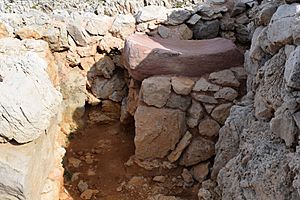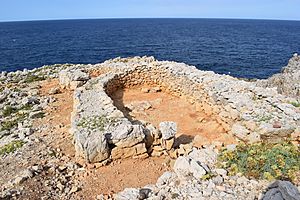Cala Morell Settlement facts for kids
The Cala Morell settlement is an ancient village found on the island of Menorca, in a place called Ciutadella de Menorca. It's a very old archaeological site from before the Talaiotic culture. This village sits on a high piece of land, about 35 meters tall, right by the sea at Cala Morell bay. A strong stone wall protects the village where it connects to the main land. Cala Morell is one of 32 amazing prehistoric sites on Menorca. These sites are hoping to become a World Heritage site, recognized by UNESCO.
What Makes Cala Morell Special?
At Cala Morell, you can see about twelve ancient houses called navetas. These unique, boat-shaped buildings were homes during the Bronze Age on Menorca and Majorca. There's also a large round stone structure, about 4 meters wide, built on the highest part of the land.
The people who lived here also dug two big holes into the rock. These might have been used to collect rainwater. All these buildings are protected by a strong dry-stone wall. This wall blocks the entrance to the village from the land side. The side facing the sea didn't need a wall because the cliffs are very high and steep, making a natural defense.
Exploring the Past
In 1996, a team from the Museum of Menorca made a map of the site. Today, archaeologists are still working there. They are from the Municipal Museum of Ciutadella and the History Museum of Manacor (Majorca). Their project is called "Entre Illes," which means "Between Islands." They are studying two coastal areas: Sa Ferradura in Mallorca and Cala Morell in Menorca.
Over the past few years, archaeologists have dug up two of the navetas (called 11 and 12). They also excavated the round stone structure on the highest point. Both navetas face south and are built against the outer wall. Inside these homes, there were benches and a hearth, which is a fireplace for cooking or warmth.
Outside naveta 11, there's a base for a grinding stone and a clay structure. These were probably used to prepare food, like grinding cereals. Naveta 12 didn't have these items, but it had two small walls that closed its entrance.
What We've Learned
Everything found at the site tells us that these navetas were homes. This includes things like pottery, bone tools (like pointed awls and flat spatulas), and grinding stones. They also found many bones from farm animals like goats, sheep, pigs, and especially cows. This shows that the people ate these animals.
Interestingly, archaeologists found almost no bones from marine animals like fish, mollusks, or crustaceans. This means that even though they lived by the sea, the people of Cala Morell didn't seem to eat or use seafood. This might seem strange, but it's something seen at many ancient sites on the island.
Scientists used Radiocarbon dating to figure out when people lived here. They believe the village was used between 1600 and 1200 BC. Researchers think the village was built on this high, protected piece of land for defense. This suggests there might have been conflicts between different groups of people back then.
See also
 In Spanish: Poblado de Cala Morell para niños
In Spanish: Poblado de Cala Morell para niños




